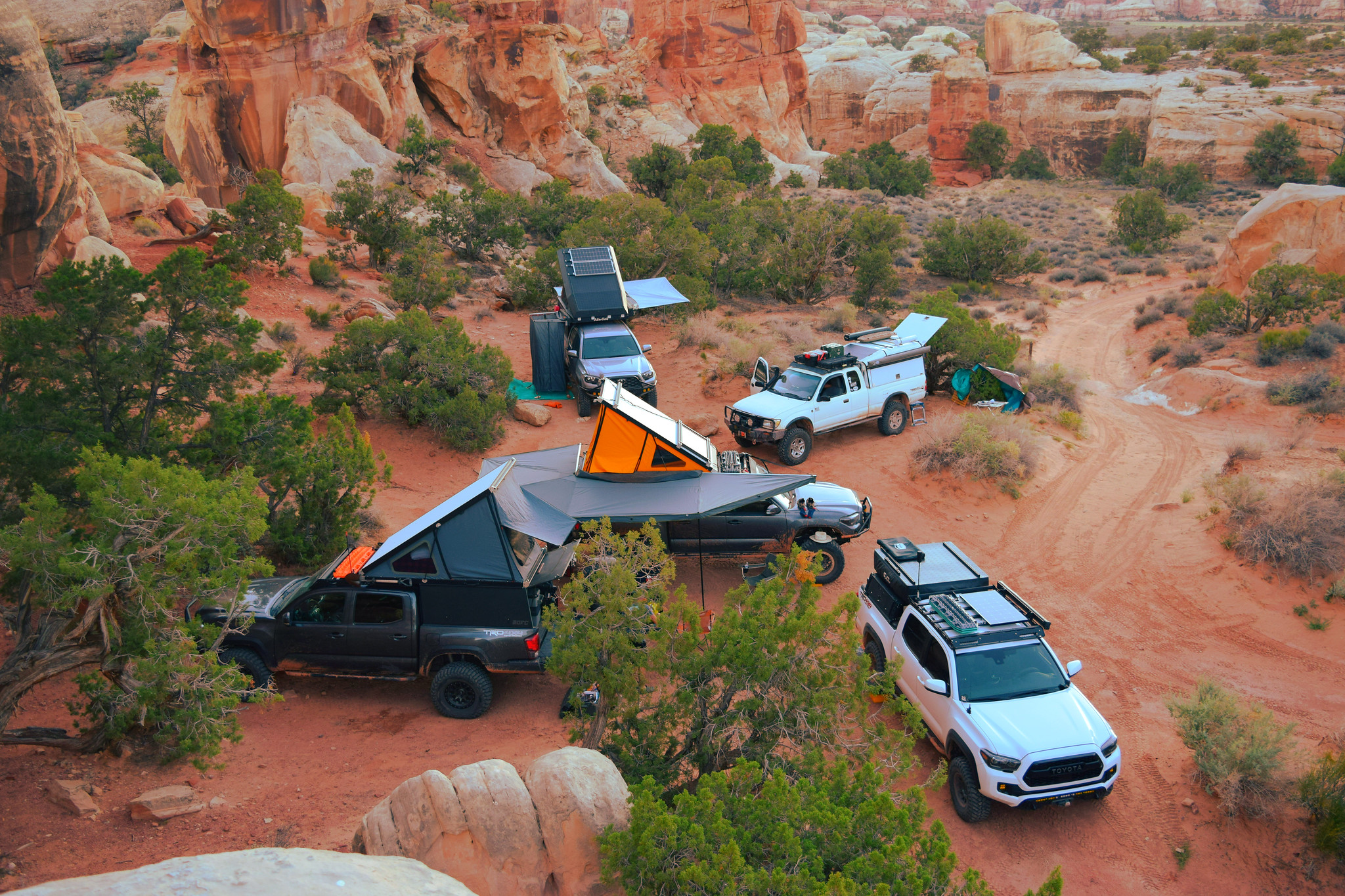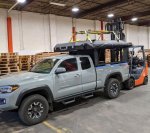I was unaware this thread existed here on Expo, excited to see an active discussion about the best camper out there!
Here are my two cents about my experiences with my Canopy Camper:
ACCC #644 on a 2021 Tacoma TRDOR DCLB.
Install:
I did the install myself, after having the camper delivered to a friends work, as they had a forklift. They package it very well for shipping, so it came in unscathed. Even has a metal exoskeleton/frame to prevent damage
Install took ~24 hours total, by myself.
I have mine 'water/dustproof'. I use quotations because the Sikaflex tends to shrink as the temperature changes (even though I applied it in November), causing small holes to form, where dust can penetrate. Word of warning, Sikaflex is great, but it is super messy. As soon as it gets on you, or you have to wipe up excess with a rag, it will get everywhere if you are not careful. It's miserable to work with, and I dread every time I have to pull it out.
Waterproofing is as follows:
- Bed rail caps to fender
- Bed bolts to bed floor
- Bedside cubby doors fully glued shut.
- Bedside cubbies removed and sealed to composite bed
- Bedside mounting tracks removed, composite bed to metal fender sealed, and then track sealed to composite bed.
- The rear of the ACCC sealed to the end of the bed, both inside and outside.
- The front of the ACCC sealed to the front of the bed. Rubber pieces wedged into the two larger gaps, and Sikaflex around those. This is sealed from both the inside and the outside.
- The ACCC sealed to the bed rail caps, both inside and outside.
- All ACCC pieces sealed to one another (rear door, tailgate portion, etc.) both inside and outside.
I used 3 tubes total to seal the camper to the truck.
I have driven in 5+ vehicle convoys in really dusty environments, and while the inside of the truck is dusty as hell, the inside of the camper is always as clean as when we set off for the day.
I had zero fitment issues with my entire camper. I did notice some small curled pieces of aluminum throughout the camper, but I have zero broken rivets on my camper. My upper bed light was installed crooked though.
*After 8 months one of my USB charging blocks, in the side channel of the bed portion of the tent, died. Short lifespan, however, the camper is in Phoenix, AZ and in the summer (when it broke) the exterior of the camper gets so hot that I cannot touch it for more than a few seconds. So that little charging block is getting cooked. If only I had a 10 ft tall garage!
Driving Characteristics:
Applicable modifications to truck:
- Full steel armor + sliders
- Steel hybrid (plate and tube) front bumper with Warn winch
- 255/85/R16's (skinny 33's), 10-ply, 60 lb each
- Archive Hammer Hangers, shackles, and cross brace
- 2.5" Radflos, custom valved, 700 lb coils, at 2" lift, paired with custom Alcan leafs, with 2" lift, at 1,200 lb of extra weight
- No front swaybar due to gusseted spindles
- Can carry up to an additional 27 gallons of liquid (water and gas) in built-in systems.
Stop and go traffic around town, shorter trips (45 mph) = 12.5 mpg
Around town driving, longer drives (45 mph) = 17 mpg
Freeway driving at 65 mph = 17.5 mpg
Freeway driving at ~72 mph = 11.5 mpg
Freeway driving above 75 mph = 9.8 mpg
Fully loaded (as I was a couple of weeks ago for a 9-day trip to The Maze), you can feel the added weight, big time, on the 7.5 hour freeway/highway drive there. Clickers cranked full stiff, it is still a heavy beast that leans its way through the bends. It is stable and easy to drive on everything other than the moderately twisty bits.
On the trail, you honestly forget you are carrying an entire house back there. With my setup, the truck doesn't even care about the weight as it crawls over rocks and drops down ledges.
I will sometimes get the subtle vibrations another poster mentioned, though it only happens around ~50 mph plus or minus 2 or 3 mph. This only happens when the truck is really empty (no water on-board, bed empty, no bikes on the rack, etc.)
Other than that, I have no complaints. I did drive the around for two months while waiting for my suspension to be ready. Even with an empty camper, the OEM suspension was severely inadequate for the weight of the ACCC.
Why I Chose the Canopy Camper: (This will be my house on wheels, so I did my research with that in mind. It needs to be as easy to use as possible, day in, day out.)
- You can store a ton of bedding up in the tent.
- The tent is super easy to open. Just two latches. I prefer the wedge life as well.
- Lead time as non-existent
- The tent fabric is secured to the lid inside of the outer edge. Makes it easier to put away and less rain gets on the fabric during normal rain events
- The actual frame of the camper itself gives you so many options for mounting things. You have more than just flat sheets of metal (GFC), no round tubes that are hard to mount to (GFC again)
- You have very easy side access with the side doors. This is crucial IMO. Climbing up and into the bed every time you need something gets old fast.
- The extra things you can buy, while pricey AF, are nice IMO. Well made and they work well together.
- The extra ~18" of tent space you get over the similar competitors. This makes it feel a lot more spacious up there. It's easy to spend all day inside of the tent.
- The fabric for the tent is very nice, and very thick, relative to the competitors. Full sun outside feels like pre-dawn inside. On my friends GFC's the fabric is almost see though. It block no sun light, and even the light from cell phone screens can be noticed at night.
- Both portions of the bedding flooring simply pivot up and out of the way, with struts to hold them in place. This is wayyyy better than the individual, movable, panels of the similar competitors.
- It isn't a slide in. Slide in's waste too much of the precious bed space IMO, and are too heavy.
- The rear door looks super cool. Plus it stores your spare effectively (OEM location is no longer viable due to Hammer Hangers (a must do mod IMO)). Also, the rear door is always vertical. Meaning you can permanently mount things to it. The other campers that leave the tailgate put you in a tricky spot. The tailgate has to be both horizontal and vertical, as does the rear door. This makes it hard to effectively use this space. Not to mention, everything in the bed of your truck is an additional ~18" away from you. Sliding drawers help you best this drawback, but sliding setups are heavy.
Photo Time:
 LM - Day 2 - 40
LM - Day 2 - 40 by
Michael Rickerd, on Flickr
 LM - Day 3 - 03
LM - Day 3 - 03 by
Michael Rickerd, on Flickr
 LM - Day 3 - 18
LM - Day 3 - 18 by
Michael Rickerd, on Flickr
 LM - Day 5 - 07
LM - Day 5 - 07 by
Michael Rickerd, on Flickr
 LM - Day 8 - 10
LM - Day 8 - 10 by
Michael Rickerd, on Flickr
 7-23 weekend
7-23 weekend by
Michael Rickerd, on Flickr
An outdated photo of some of the interior buildout. All custom. More custom storage is 50% done as of today.
 ACCC Interior
ACCC Interior by
Michael Rickerd, on Flickr
Long story short, I love this thing. If you're on the fence, get one. If you're on the fence about which brand to get, and you can afford the ACCC, get it. All my friends with GFC's agree that the ACCC is the better product for the more serious adventurer, though the extra cost over the GFC's is what ultimately turned them away. If they could have afforded it, they would have got it.





 LM - Day 2 - 40
LM - Day 2 - 40 LM - Day 3 - 03
LM - Day 3 - 03 LM - Day 3 - 18
LM - Day 3 - 18 LM - Day 5 - 07
LM - Day 5 - 07 LM - Day 8 - 10
LM - Day 8 - 10 7-23 weekend
7-23 weekend ACCC Interior
ACCC Interior